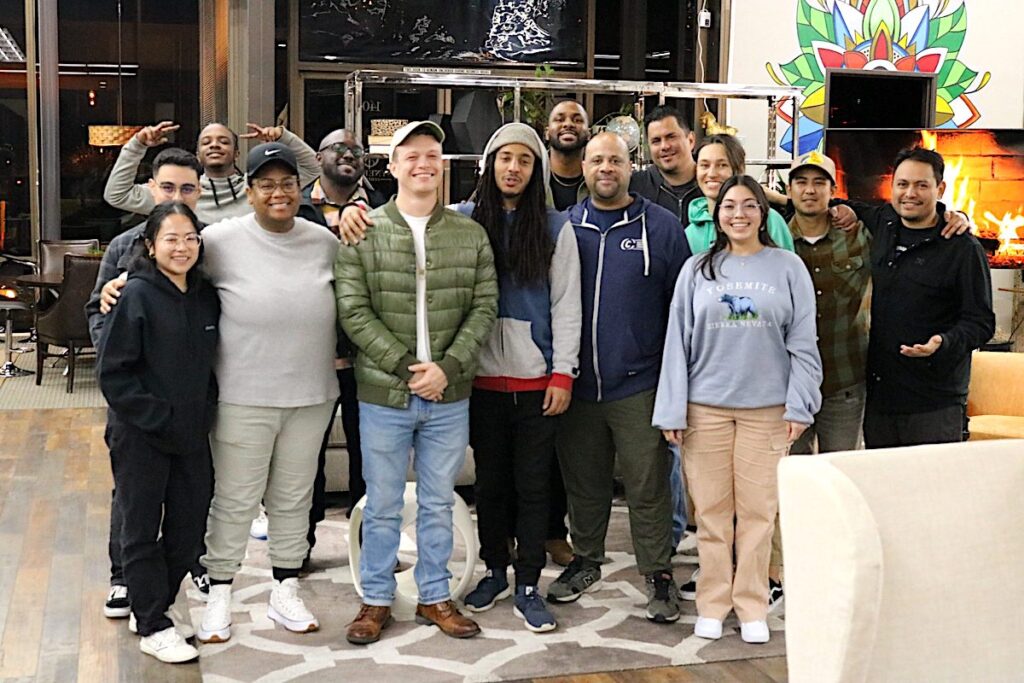Building sustainable earn and learn programs isn’t just about opening doors—it’s about rethinking how we fund and support talent. When I started my small nonprofit organization, we were met with a lot of uncertainty. We had to navigate the challenges of launching an apprenticeship program without traditional funding. As a result, we developed innovative funding models that didn’t rely solely on grants. I’m going to share with you my blueprint for funding successful earn while you learn pipelines. Ultimately, the goal isn’t just to place people in jobs—it’s to create lasting career opportunities that reshape the workforce for the better.
What Is An Earn and Learn Program?
Taking time off without income to go to community college, gain technical skills, or earn certifications to change careers or level up is tough for most people, especially adults with families or financial constraints.
An apprenticeship may be the best earn and learn program in that it involves a work-based learning approach where you can gain new skills for a certain career path while receiving a paycheck.
It’s a great way to gain job experience that can either help you level up in your current field or help you switch industries entirely without having to go into debt.
When I think about apprenticeships, I picture a real, hands-on journey that changes lives.
How Is Earn and Learn Different From An Internship?
We’ve all heard of young people getting internships fresh out of college or maybe even before graduation. The major difference between these interns and an apprentice is that the apprentice is getting paid while they’re learning on-the-job skills and training.
Oftentimes, an intern may not receive a job offer when they finish, depending on the program. Apprenticeships often provide work experiences that are more likely to lead to employment opportunities.
Funding Earn and Learn Programs Without Grants Video
Recently, I gave a talk about how we’re rethinking apprenticeship models—using creative funding methods to make these programs sustainable without relying solely on grants. I want to share that story with you in plain language.
Starting My Own Nonprofit Apprenticeship Program
I run a small nonprofit in California called Creating Coding Careers that’s all about high-intervention support. That means we’re not just helping people get a foot in the door—we’re investing in them from day one. Sometimes, we even become the employer of record to give our participants the real chance they need to grow.
Crisis Before We Even Began
Back in 2019, we had just received approval from the state’s Department of Apprenticeship Standards to operate our program. But on the very same day that we were launching our first classes, COVID hit. Suddenly, the companies we were counting on froze their hiring. It was a wake-up call, and I realized we had to pivot—and quickly.
At first, the idea of taking our apprenticeship program fully online didn’t excite me at all. I come from a background where in-person learning—spending 40 to 60 hours a week in a classroom with an instructor—was the gold standard. But despite my concerns, we pushed forward, determined to find a new path.

Investing in Talent: The $33,000 Question
Amid the chaos of launching our nonprofit organization during the start of the COVID pandemic, we discovered something important: we needed a sustainable way to fund our apprenticeships.
That meant looking at how we could generate around $33,000 per apprentice without leaning too hard on grants. This $33,000 isn’t just a price tag—it’s the investment required to transform someone into a high-wage, high-growth career professional over six to twelve months. In our model, about 70 percent of that amount goes toward wages and benefits, while the remaining 30 percent covers training, oversight, and all the extra support that makes the apprenticeship work.
One of the things I’ve learned over my decades as a software engineer—and later as a CEO—is that talent is an investment, not a cost. This idea has shaped every earn and learn model we’ve developed. Our focus is on creating a path where early career professionals receive real-world experience and guidance, whether it’s through our pre-apprenticeship training or through full-scale, paid apprenticeship programs.
Innovative Models to Fund Apprenticeships
When we started, we knew that simply relying on grants wouldn’t cut it. We had to create funding models that allowed us to generate revenue from employers directly. I remember asking the room a simple question: “How would you fund an apprenticeship program if you had to come up with $33,000 per person, without relying on grants?” The answers were creative. Some people suggested combining different funding streams, while others looked at the potential of working with existing budgets within organizations.
Model One: Offering Services
One of our early models was simple: we stepped into the business world by offering software services. The idea was to have our apprentices work on tasks that were lower on the priority list for companies but still needed to be done. By doing this, we provided real value to those companies while giving our apprentices hands-on experience.
Imagine walking into a business and saying, “I know you have a backlog of work that your team isn’t able to get to right now. Let us help, and you’ll also get a preview of future talent for your team.” That approach got results and provided fast revenue—but we quickly learned that while this model was a great starting point, it was hard to scale.
Model Two: Contract to Hire
Another model we explored was a “contract-to-hire” or “front-loaded training” approach. In this scenario, we would invest upfront to train an apprentice full-time. Once they were ready, we’d partner with a company that needed talent and offer a contract-to-hire arrangement. The company would cover the training costs for three to six months, and if they liked what they saw, they could convert the apprentice into a full-time employee.
This model made sense because it allowed companies to see the value before making a long-term commitment. Still, it came with its own set of challenges—like building up a bench of talent that isn’t immediately generating revenue.
Model Three: Program Management
Our third model focuses on embedding apprenticeship programs directly within organizations by securing internal champions—decision-makers with hiring authority and budget. Rather than handling everything in-house, we guide companies through the process, managing registration, coaching, mentorship, and apprentice development while ensuring we hire apprentices on day one.
We’ve seen a lot of success with this approach, with many apprentices transitioning into full-time software engineering roles with competitive salaries and benefits. One of the challenges of this system is securing long-term buy-in from corporate leadership. Sometimes programs can take time to gain traction and could change if internal advocates leave their company.
However, once a company commits, scaling becomes much easier—starting with a small pilot cohort and gradually expanding. Ultimately, this model leverages corporate funding, making it one of the most scalable and sustainable approaches to apprenticeship development.

Apprenticeship Degrees: Rethinking Education
One of the most exciting aspects of our approach is what we call apprenticeship degrees. Many companies ask, “Do they have degrees?” With our approach, the answer becomes, “With an apprenticeship degree, they are on a pathway to a degree (like interns), but they are being educated for the specific needs of your company and building a relationship that is far more likely to convert into a full-time employee than an internship.”
This approach not only addresses the skills gap but also gives companies a clear alternative to conventional hiring. Apprenticeship degrees show that real-world skills and hands-on training can be at least as valuable as a traditional degree from a university.
SkillBridge: Transitioning Veterans into Tech Professionals
Creating Coding Careers also offers a successful model with our SkillBridge program. For those who aren’t familiar, SkillBridge is a Department of Defense initiative that allows transitioning service members to work in a civilian role while still receiving military pay and benefits. CCC’s VA-approved SkillBridge program has some unique advantages over other SkillBridge programs, including a housing allowance that is activated immediately upon concluding military service with enrollment in our program.
We saw a perfect opportunity to blend SkillBridge with our apprenticeship programs, giving veterans a seamless transition into technology careers. This not only provided immense value to the veterans but also helped companies tap into a pool of disciplined, highly trained talent, often with required security clearances that would ordinarily take a long time for a candidate to get.
Realizing the Return on Investment of Backing New Talent
Let’s talk about the numbers for a moment. The $33,000 investment per apprentice might seem like a big ask, but when you break it down—70 percent goes to wages and benefits during a training period, and the rest covers necessary training and oversight—it becomes a predictable investment that can yield strong returns.
When an apprentice is fully trained and starts contributing as a regular employee, that initial investment pays off quickly, especially compared to the cost of hiring someone who isn’t job-ready. Employers incur substantial costs to replace a worker with direct hiring. With apprenticeships, retention is much higher which saves employers on hiring expenses.
Ensuring Quality Candidates With Pre-Apprenticeship Curriculum
A key part of our model is how we integrate pre-apprenticeship training. We’ve made our pre-apprenticeship programs accessible online and self-paced, ensuring that everyone has a chance to get started without a huge upfront cost. While thousands have begun our pre-apprenticeship training, we can only take a small percentage into our full apprenticeship programs. This scarcity helps keep the quality high and ensures that every apprentice is well-prepared when they step into the workplace.
Investing in a Better Tomorrow
When you combine hands-on training, real employer engagement, flexible funding models, and programs like SkillBridge, the future of apprenticeship becomes incredibly exciting. We’re not just preparing people for a job—we’re building pathways for careers. And with apprenticeship degrees, we’re breaking down the old barriers between formal education and on-the-job training.
These earn and learn models aren’t perfect from the start. There have been bumps along the way, and we’ve had to pivot when funding sources dried up or when market conditions shifted. But every challenge has been a learning opportunity. We learned early on that sustainable funding for apprenticeships isn’t about chasing grants—it’s about creating systems where employers see the value in investing directly in talent.
Apprenticeships to Change the Traditional Career Path
Imagine a world where every company has the opportunity to tap into a ready pipeline of skilled professionals. A world where apprenticeships aren’t just a fallback for those who can’t get a degree or a traditional job, but a preferred pathway to a fulfilling career. That’s the world we’re working to build. When we invest in real talent through well-designed apprenticeship programs, we’re not only building careers—we’re building a better future for all of us.
So let’s keep the momentum going, keep asking the hard questions, and keep pushing for change. The journey isn’t easy, but every step we take is a step toward a brighter tomorrow. If you’re curious about apprenticeship models or want to chat about funding apprenticeships and earn-and-learn strategies, let’s connect and keep the conversation going!
